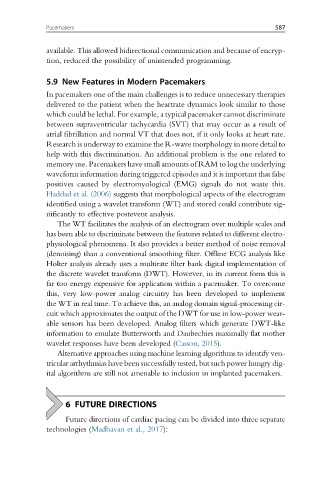Page 596 - Handbook of Biomechatronics
P. 596
Pacemakers 587
available. This allowed bidirectional communication and because of encryp-
tion, reduced the possibility of unintended programming.
5.9 New Features in Modern Pacemakers
In pacemakers one of the main challenges is to reduce unnecessary therapies
delivered to the patient when the heartrate dynamics look similar to those
which could be lethal. For example, a typical pacemaker cannot discriminate
between supraventricular tachycardia (SVT) that may occur as a result of
atrial fibrillation and normal VT that does not, if it only looks at heart rate.
Research is underway to examine the R-wave morphology in more detail to
help with this discrimination. An additional problem is the one related to
memory use. Pacemakers have small amounts of RAM to log the underlying
waveform information during triggered episodes and it is important that false
positives caused by electromyological (EMG) signals do not waste this.
Haddad et al. (2006) suggests that morphological aspects of the electrogram
identified using a wavelet transform (WT) and stored could contribute sig-
nificantly to effective postevent analysis.
The WT facilitates the analysis of an electrogram over multiple scales and
has been able to discriminate between the features related to different electro-
physiological phenomena. It also provides a better method of noise removal
(denoising) than a conventional smoothing filter. Offline ECG analysis like
Holter analysis already uses a multirate filter bank digital implementation of
the discrete wavelet transform (DWT). However, in its current form this is
far too energy expensive for application within a pacemaker. To overcome
this, very low-power analog circuitry has been developed to implement
the WT in real time. To achieve this, an analog domain signal-processing cir-
cuit which approximates the output of the DWT for use in low-power wear-
able sensors has been developed. Analog filters which generate DWT-like
information to emulate Butterworth and Daubechies maximally flat mother
wavelet responses have been developed (Casson, 2015).
Alternative approaches using machine learning algorithms to identify ven-
tricular arrhythmias have been successfully tested, but such power hungry dig-
ital algorithms are still not amenable to inclusion in implanted pacemakers.
6 FUTURE DIRECTIONS
Future directions of cardiac pacing can be divided into three separate
technologies (Madhavan et al., 2017):

